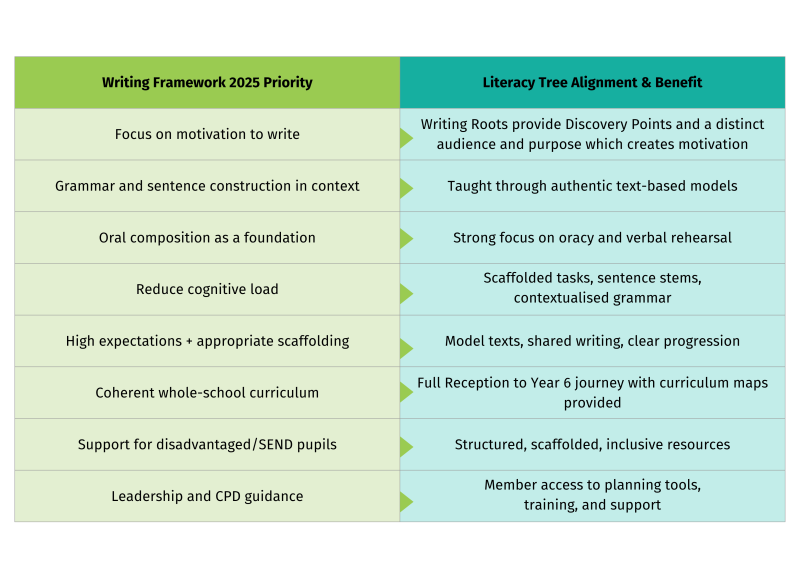Literacy Tree doesn’t just align with the Writing Framework 2025, it already embodies the best practices suggested within the document. This means schools don’t need to drastically change what they do; instead, they can deepen their approach and review impact with confidence, knowing their approach is supported by national evidence and policy.
Overview & Purpose
Aimed at Reception to Year 6, the framework outlines an evidence-based, sequenced approach to teaching writing for primary pupils. It supports practitioners with practical guidance, aligned to the Early Years Foundation Stage and National Curriculum.
Key Messages from the Summary
- Writing is cognitively demanding: teaching must be scaffolded to manage pupils’ working memory.
- Early transcription mastery: handwriting and spelling must begin in Reception, becoming automatic to free working memory.
- Sentence-level focus: grammar instruction must support sentence control and convey meaning but not taught in isolation.
- Oral composition matters: speaking through ideas underpins writing fluency, even once transcription skills are solid.
- Prioritise quality over quantity: children shouldn’t be expected to write at length until foundational skills are secure.
- Vital Reception year: this stage lays the groundwork for writing success throughout primary school.
- Early identification & support: teachers should spot and support pupils needing help as early as possible.
In-Depth Guidance
Section 1: Explains writing’s importance, the “Simple View of Writing,” and introduces cognitive load and motivation.
Section 3: Provides detailed advice on handwriting, spelling, and even typing, to develop transcription skills.
Section 4: Covers sentence construction, grammar in context, vocabulary development, writing process (planning, drafting, editing), plus audience and structure guidance.
Section 5: Focuses on support strategies for pupils with additional needs .
Section 7: Guides leaders on fostering a writing culture, designing curriculum sequences, and assessing writing .
Section 8: Reviews national assessments (EYFS, phonics check, KS1 and KS2).
In Summary:
The framework offers a comprehensive, research-informed, and practical guide for teaching writing.
It strongly emphasises:
1. Early and consistent instruction in handwriting and spelling to build fluency.
2. The sentence as the unit of composition, supported by grammar and vocabulary.
3. Oral composition and working memory management.
4. Early identification and intervention for pupils who struggle.
5. Leadership’s role in developing a strong writing culture and curriculum coherence.
Literacy Tree members are well-positioned to benefit in multiple ways because the structure and ethos of Literacy Tree already aligns closely with the framework’s recommendations. Here’s a breakdown of the key benefits:
- Alignment with DfE Priorities (Whole School Programme)
Benefit: Members can feel confident that their teaching is aligned with current national guidance.
The Writing Framework emphasises explicit, sequenced writing instruction which Literacy Tree already delivers through our book-based, structured Writing Roots.The Teach Through a Text pedagogical model mirrors the framework’s focus on cognitive scaffolding and structured composition.
- Focus on Motivation to Write (Teach Through a Text)
Benefit: Literacy Tree has a strong pedagogical model which is deliberately designed to immerse children within the text, therefore engaging deeply and motivating children to write.
This directly addresses the framework’s inclusion of the research behind the importance of motivation within the writing process.
- Early Focus on Transcription (Spelling Seeds)
Benefit: Literacy Tree’s emphasis on developing transcription skills early through the Spelling Seeds resource where application is key, supports the framework’s call for fluency to reduce cognitive load.
This is particularly valuable in KS1, where automaticity is a central goal.
- Reducing Cognitive Load through Integrated Instruction (Writing Roots)
Benefit: Literacy Tree plans teach grammar, vocabulary, and sentence construction in context, which supports working memory and avoids abstract decontextualised instruction.
This directly addresses the framework’s emphasis on supporting children’s cognitive processes. Many of the cognitive tools, e.g. Shades of Meaning, Zones of Relevance, Emotions Graphs are repeated.
- Oral Composition is Built In (Writing Roots) and Explicit Vocabulary Instruction (Vocabulary Vines)
Benefit: Literacy Tree places a strong emphasis on speaking and rehearsal before writing.
This matches the framework’s stress on oral language as a foundation for writing which is especially important in Reception and Year 1. The Vocabulary Vines resource reinforces the framework’s call for explicit instruction that improves pupils understanding of how to apply words and phrases.
- Strong Reception-Year Provision
Benefit: Literacy Tree’s Reception materials offer well-sequenced early writing support using picture books and oracy.
This is in line with the framework’s insistence that Reception lays the groundwork for later writing success.
- Integrated Support for Struggling Writers
Benefit: Literacy Tree scaffolds writing using sentence stems, modelled writing, and shared composition. This is exactly the kind of strategies promoted in the Framework for supporting SEND and low-attaining pupils.
The consistent structure also aids pupils who benefit from predictability and repetition.
- Whole-School Coherence and Culture
Benefit: The Writing Framework urges leaders to design coherent writing curriculums across phases and Literacy Tree already provides a complete mapped journey from Reception to Year 6 with full National Curriculum coverage.
This makes it easier for schools to implement the Framework without starting from scratch.
‘Leaders may consider purchasing a writing programme to support the teaching of one or more aspects of the writing curriculum. There may be a role for programmes in training and guiding teachers. A rigorous programme that includes well-conceived and structured resources can help to ensure consistency if a school has a strong, clear rationale for using one’.
- Built-In Professional Development
Benefit: Literacy Tree members get access to CPD materials, planning guidance, and videos - helping staff apply the Framework with confidence and consistency.

Posted in: Curriculum
